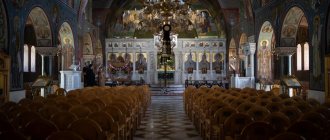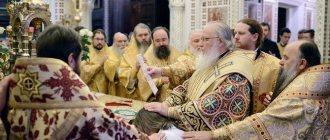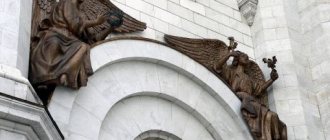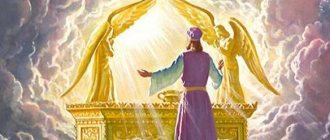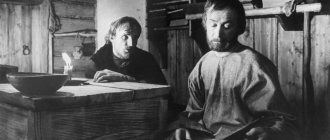Who is this?
The word comes from the Greek term for elder.
In common parlance today they are often simply called priests. This is due to the fact that in the main traditional confessions the term “Presbyter” designates the second level of the priesthood.
The majority of clergy that parishioners of both the Orthodox Church and other historical confessions encounter are precisely presbyters or simply priests.
Important! When can you get to the Church of St. Sergius of Radonezh in Businovo
Of these, rectors of parishes and cathedrals are almost always appointed. They also administer most of the sacraments, except for ordination and (in Catholicism) confirmation, and perform other sacred rites.
Who ordains?
Scripture shows us Paul and the one to whom he entrusted this responsibility - Titus. He also writes about this to Timothy. Paul served as an apostle. Timothy is also spoken of as an apostle. Titus carried out various assignments from Paul related to the donation and care of churches. Even in the book of Acts it is said that Paul and Barnabas, the apostles, ordained elders.
So, the Apostles and those people whom they appointed as caretakers of churches could ordain elders who met certain criteria.
In the early church
The word “presbyter” can be found already in the New Testament. It can be encountered especially often in the Acts of the Apostles. As Wikipedia says, at that time he was not always a person, hierarchically at the next level of the priesthood, after the bishop.
In apostolic times, this term often simply meant the elder in the Christian community. Sometimes one of the apostles was called this way. At the same time, already in the New Testament texts there is a difference between presbytery as an honorary title and ministry. It appears even more clearly in the writings of the apostolic and early Christian apologists.
Important!
From the very beginning of Christianity, certain requirements were imposed on candidates for priesthood. And the laity also participated in their election, although the right of consecration belonged only to the bishop. The Council of Laodicea abolished the participation of the laity in the election.
From the texts of the next generation we can get an idea of what the duties of the early Christian priest were:
- bless Church members;
- to replace the bishop as chairman of the assembly of the faithful;
- teach the faith instead of the bishop and with his blessing;
- teach the sacraments, in addition to the priesthood itself, and the performance of sacred rites;
- accept confession.
The bishop governed the diocese entrusted to him, consulting with the priests, whose college was called the “presbytery.” They were also called to councils, where they took seats behind the episcopate.
Interesting! What is father Herman’s reprimand for drunkenness and how to get there
The outstanding role played by priests in the life of the church often resulted in a difficult fate for them during periods of persecution. Among them we can meet many martyrs, such as Elymas, a presbyter in Babylon who suffered under the emperor Decius, who became lights of the Christian faith even after death. Martyrs from the second priestly rank are called holy martyrs.
History of the rank
Previously, old age among the people was considered as a divine miracle, wisdom and blessing, since few lived to see gray hair. Elders are also mentioned in the Bible as examples of godliness and they created family order.
The first mention of this rank was in Jerusalem. The earliest Christian Church in Jerusalem had a college under its control, where they trained as assistants to the bishop, it was very similar to the Jewish synagogue. Initially, in Christianity, the elder was the head of the community; he performed the functions of the Bishop.
Ordination to the Presbyterate
Now this rank is not so high. On the hierarchical ladder he stands between the deacon and the bishop. The presbyter in the church performs the duties of a bishop, he performs sacred services, organizes the social life of parishioners, monitors the parish and the condition of the temple.
Responsibilities of elders:
- bestowing blessings on believers;
- preaching the faith with the permission of the Bishop;
- perform the duties of the Bishop in his absence;
- serving God, performing the sacraments.
Interesting! The literal translation of the word presbyter from the Greek is elder. The apostles called themselves this, based on the Old Testament Church, where the presbyter in the hierarchy was the second sacred rank.
In Orthodoxy
Who is a presbyter in the Orthodox Church today? How different is his role from the one we
can we meet in ancient times?
The Orthodox priesthood finally took shape by the 5th–6th centuries, when the roles were clearly divided between three ranks - bishop (or bishop), presbyter (or priest) and deacon.
Subsequently, the main changes concerned the requirements for education, moral character and age of candidates.
The priest is assigned the role of the chief assistant and deputy bishop in the rites and teaching the faith of Orthodox Christians. Therefore, it is so important that he has the proper level of education.
Informative! The history of the All-Tsaritsa icon: what is its meaning and how does the image help?
In accordance with the canon law of the Russian Church, a candidate for ordination in Russia must:
- Complete a full course of theological education at a seminary or theological academy. Although in certain cases, the ruling bishop may allow a deacon who has not graduated from the seminary, or a secular person, to become a priest. But they must prove their knowledge and trustworthiness.
- Reach the age specified by the canons. Even by ancient councils it was defined as 30 years. As in the case of education, deviation from this rule is allowed, but only if there are really serious reasons.
- Be either already married to an Orthodox woman or celibate, declaring his desire to remain in this state forever. Widowers are also allowed to be ordained.
- The moral qualities of the candidate must be impeccable.
Important!
Orthodox canons put forward certain rules for the physical appearance of candidates. True, they are not so strict. It is important here that physical disabilities do not become an obstacle for the ordained person to perform priestly functions in the future. Therefore, deaf, dumb, blind and immobile persons cannot become priests.
Unmarried priests who have become monastics can become bishops.
As a conclusion
Unfortunately, today many congregations are moving away from the biblical form of ministry and management. New ministries appear (leader, missionary), new rules and requirements for ministers appear. As I said at the beginning, everyone himself will answer before God for his attitude towards the Word. For the way you confess His Word. How you teach.
It is very easy to misinterpret another person's words. But we touch the Word. The disciples MADE A CONCLUSION BASED ON THE WORDS OF Christ. But we see a correction - Jesus DIDN'T SAY what the disciples claimed.
In other denominations
In Catholicism, as well as in Protestant communities where the bishopric has been preserved, presbyters occupy the same position.
place in the hierarchy as in Orthodoxy. Their functions are also very similar. The only difference is that in the Catholic Church, confirmation is administered only by the bishop.
Many Protestant denominations do not recognize the priesthood as a sacrament, which leaves its mark on the role of the elder, which primarily becomes administrative and teaching.
In addition, there are Presbyterian churches where there are no bishops. In them, the entire administration of church affairs is in the hands of a college of elders.
Interesting! How to be baptized correctly as an Orthodox Christian
As in Orthodoxy, in the Catholic Church and most historical Protestant denominations (Lutheranism, Calvinism, Anglicanism), candidates for the role of elder are required to meet certain minimum age, education and lifestyle requirements.
Catholic Latin priests, for example, are required to remain celibate. At the same time, this does not apply to Protestant pastors - moreover, they can often get married after they have taken office.
Recently, many Protestant denominations have opened their doors to female elders, and some have gone further by appointing women bishops. This applies to both Lutherans (Church of Sweden) and Anglicans (Church of England, Episcopal Church USA).
Ordination of an elder
So, we see that such qualities of an elder should be visible to everyone. It is very important. Today's practice of appointing ministers in churches (for some reason, pastors) shows that people are sometimes appointed from the outside, whom the congregation does not know. Those who have completed certain courses and have a certificate are awarded. Or simply the husband or wife of a minister automatically becomes a minister. In one of the denominations, the rule is to change the pastor every three years.
I do not want to consider or delve into such practices. Our task is to see how the Word speaks. And to be obedient to Scripture or human traditions is the choice of every person.
Presbyterianism
Among the many directions of Protestantism, there is one that took its name from the rank of elders - Presbyterianism.
Anyone who is interested in the question of what the Presbyterian Church is will have to turn to the teachings of the French theologian John Calvin, which formed the basis of the teachings of this denomination. It was his rethinking on the soil of Scotland that gave birth to it.
The main feature of Presbyterianism was the absence of episcopacy. This denomination is organized according to the congregational principle:
- Parishes are led by pastors and a council of elders.
- Several parishes make up presbyteries.
- General synods, which are the highest governing body, are formed by representatives of the presbyteries.
In this denomination, elders are called not only the pastors who lead the community, but also the elders elected by it and those in charge of financial and administrative matters.
The elders are assisted by deacons. Thus, the Presbyterian Church is devoid of such a strict hierarchical principle typical of Orthodoxy, Catholicism or Lutheranism.
Although the first Calvinists appeared in the Muscovite kingdom back in the 16th century, real Presbyterianism appeared in the Russian Empire in the middle of the 19th century. In 1860, the US missionary Easton and the Turkish preacher Kashamosh organized the first Presbyterian communities in the Yerevan province, which gradually grew throughout the empire.
Important! The most powerful Orthodox prayers for all occasions
Today, Presbyterianism is represented in most regions of Russia, especially strongly in Moscow and St. Petersburg. The communities of the northern capital are united by the Council of Pastors of Presbyterian Churches of St. Petersburg, which is an unregistered coordinating body.
